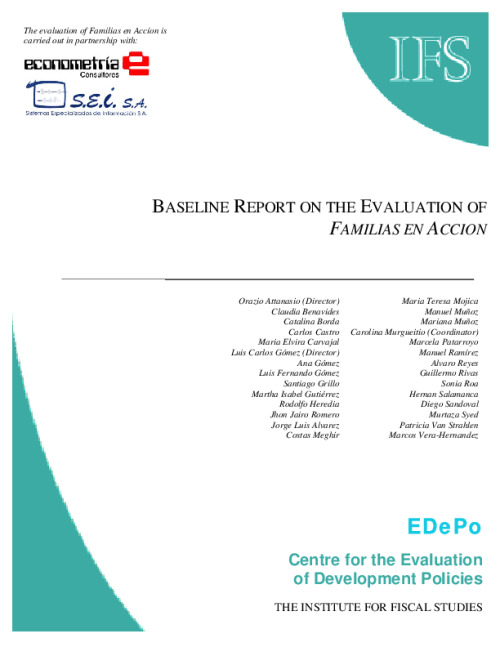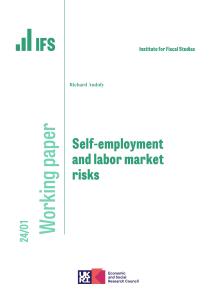In this report, we will not describe in detail the programme or the methodology of the proposed evaluation, as this was done in IFS-Econometria-SEI (2003a). The main aim of the document is to discuss the first, baseline survey that was collected for this evaluation. While the baseline survey cannot, by definition, be used to perform impact evaluation, towards the end of the report we exploit the slightly peculiar way in which the programme was started and have a first very preliminary glance at some of the impacts that the programme might have. The methodological caveats on interpreting these results should be taken very seriously.
This report does not contain an extensive Ѧieldwork' report. This is included in SEI (2003). Analogously, we do not discuss extensively the operation of the programme and the evidence that emerged on related issues and on targeting. These issues are covered in IFS-Econometria- SEI (2003b, 2003c). We will be referring to some of the issues raised in those reports, however.
This report is divided into five chapters. In Chapter 1, we briefly summarise the main features of the programme and its proposed evaluation. A more detailed description of both of these aspects is contained in IFS-Econometria-SEI (2003a). Here, however, we give some details on the expansion of the programme and on the features of this expansion that allow a first and preliminary analysis of the impact of the programme. In Chapter 2, we describe the statistical methodology that will be used in the report. This includes the methodology for the data description that constitutes the largest part of the report and for the preliminary impact evaluation. Chapter 3 describes the baseline survey. This chapter is divided into several sections, each referring to a particular module. In each section, we first describe the Ѵreatmentҍ population ֠that is, the households eligible for the programme that were living in villages targeted by the programme. We then move on to the population living in ѣontrol' villages ֍ that is, in villages that were not targeted by the programme and yet are, nonetheless, reasonably similar to the treatment villages. Chapter 4 presents the preliminary impact evaluation. This report describes the survey that was carried out in 122 communities in rural Colombia by the consortium formed by the Institute for Fiscal Studies, Econometria and SEI as the baseline for the impact evaluation of Familias en Acción, a programme to foster the accumulation of human capital in rural Colombia, run by the Colombian government.
In this report, we will not describe in detail the programme or the methodology of the proposed evaluation, as this was done in IFS-Econometria-SEI (2003a). The main aim of the document is to discuss the first, baseline survey that was collected for this evaluation. While the baseline survey cannot, by definition, be used to perform impact evaluation, towards the end of the report we exploit the slightly peculiar way in which the programme was started and have a first very preliminary glance at some of the impacts that the programme might have. The methodological caveats on interpreting these results should be taken very seriously.
This report does not contain an extensive Ѧieldwork' report. This is included in SEI (2003). Analogously, we do not discuss extensively the operation of the programme and the evidence that emerged on related issues and on targeting. These issues are covered in IFS-Econometria- SEI (2003b, 2003c). We will be referring to some of the issues raised in those reports, however.
This report is divided into five chapters. In Chapter 1, we briefly summarise the main features of the programme and its proposed evaluation. A more detailed description of both of these aspects is contained in IFS-Econometria-SEI (2003a). Here, however, we give some details on the expansion of the programme and on the features of this expansion that allow a first and preliminary analysis of the impact of the programme. In Chapter 2, we describe the statistical methodology that will be used in the report. This includes the methodology for the data description that constitutes the largest part of the report and for the preliminary impact evaluation. Chapter 3 describes the baseline survey. This chapter is divided into several sections, each referring to a particular module. In each section, we first describe the Ѵreatmentҍ population ֠that is, the households eligible for the programme that were living in villages targeted by the programme. We then move on to the population living in ѣontrol' villages ֍ that is, in villages that were not targeted by the programme and yet are, nonetheless, reasonably similar to the treatment villages. Chapter 4 presents the preliminary impact evaluation.












